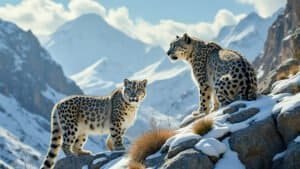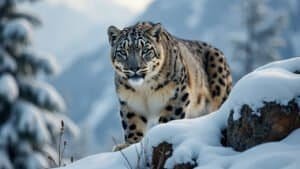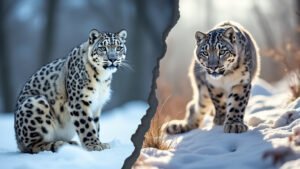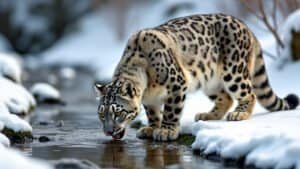Introduction
The geographic ranges of big cats reveal fascinating insights into their adaptations and ecological niches. This article delves into the snow leopard’s range and compares it with other big cats, including tigers, lions, jaguars, and leopards
By examining key regions, overlapping territories, and the impact of human activity, we will uncover how these magnificent predators thrive in their respective environments. Understanding these ranges not only highlights the diversity of big cat habitats but also underscores the importance of conservation efforts
Geographic Range of Snow Leopards
The snow leopard (Panthera uncia) inhabits the rugged mountainous regions of Central and South Asia
Their range spans 12 countries: Afghanistan, Bhutan, China, India, Kazakhstan, Kyrgyzstan, Mongolia, Nepal, Pakistan, Russia, Tajikistan, and Uzbekistan. These elusive big cats are typically found at altitudes between 9,800 and 17,000 feet, in areas with steep terrain, rocky outcrops, and sparse vegetation
Snow leopards have adapted to survive in harsh, cold environments. Their thick fur, wide nasal cavities, and powerful limbs help them navigate and thrive in their high-altitude habitats. These regions are characterized by their inaccessibility, which offers the snow leopard a degree of protection from human disturbances
However, these same characteristics make it challenging for researchers to study them, leading to a lack of comprehensive data on their exact population numbers and distribution
Overview of Snow Leopard Habitat
The habitat of the snow leopard is primarily dictated by the need for prey and suitable terrain. Snow leopards prefer areas with abundant prey such as blue sheep (bharal), argali, ibex, marmots, pikas, and hares
Their territories can cover extensive areas, often between 19 and 38 square miles, depending on prey density and availability. They utilize rocky outcrops and steep cliffs for hunting, resting, and raising their cubs, leveraging their powerful build to navigate these challenging landscapes
The snow leopard’s habitat varies with the seasons. In summer, they tend to stay at higher altitudes to remain within cooler climates, moving to lower altitudes during winter to avoid deep snow and access more prey. This seasonal migration is crucial for their survival and reproductive success
Key Regions for Snow Leopards
Key regions for snow leopards include the Himalayas, the Qinghai-Tibet Plateau, and the mountainous areas of the Altai, Pamir, and Tien Shan ranges. The Himalayas, spanning five countries, provide a significant portion of the snow leopard’s habitat
In China, which harbors approximately 60% of the global snow leopard population, they are found in provinces like Xinjiang, Qinghai, and Tibet
Mongolia is another critical region, hosting vast expanses of suitable habitat in its western mountain ranges. The Altai Mountains in Russia, shared with neighboring countries, also play a vital role in supporting snow leopard populations. Each of these regions presents unique ecological conditions that shape the snow leopard’s behavior and survival strategies
Factors Influencing Snow Leopard Distribution
Several factors influence the distribution of snow leopards, including prey availability, human encroachment, and climate change
Prey availability is the most critical factor, as snow leopards require a stable and abundant food source to sustain their populations. Areas with high prey density tend to have higher concentrations of snow leopards
Human encroachment through activities like livestock grazing, mining, and infrastructure development has fragmented snow leopard habitats. This fragmentation reduces their ability to roam freely and find sufficient prey, leading to increased human-wildlife conflicts. In some areas, snow leopards have been known to prey on livestock, which can result in retaliatory killings by herders
Climate change poses a significant threat to snow leopard habitats. Rising temperatures can alter the distribution of prey species and shift vegetation zones, potentially pushing snow leopards to even higher altitudes where conditions may be less suitable
Additionally, changing weather patterns can affect snow and ice cover, further impacting the snow leopard’s habitat and hunting grounds
Conservation Efforts
Conservation efforts for snow leopards focus on habitat protection, reducing human-wildlife conflicts, and fostering community engagement
International initiatives like the Global Snow Leopard and Ecosystem Protection Program (GSLEP) aim to secure 20 snow leopard landscapes by 2020. These efforts involve collaboration between governments, conservation organizations, and local communities to create sustainable solutions for snow leopard conservation
Community-based conservation programs, such as those implemented by the Snow Leopard Trust, work directly with local people to mitigate conflict and promote coexistence. These programs include livestock insurance schemes, predator-proof corrals, and alternative livelihood projects to reduce dependence on grazing
Research and monitoring are also essential components of conservation. Advances in technology, such as camera traps and GPS collars, have improved our understanding of snow leopard behavior and distribution. These tools help researchers gather data on population dynamics, movement patterns, and habitat use, informing more effective conservation strategies
Comparison with Tiger Range
The tiger (Panthera tigris) is another iconic big cat with a broad geographic range, though it is markedly different from the snow leopard’s. Tigers are found primarily in the forests, grasslands, and wetlands of Asia
Their range once extended from Turkey through South and Southeast Asia to the far eastern shores of Russia, but habitat loss and poaching have significantly reduced their territories
Geographic Range of Tigers
Tigers are currently found in 13 countries: Bangladesh, Bhutan, Cambodia, China, India, Indonesia, Laos, Malaysia, Myanmar, Nepal, Russia, Thailand, and Vietnam
The majority of the world’s tiger population resides in India, which is home to over 70% of the global tiger population. Key regions for tigers include the Sundarbans mangrove forest shared by India and Bangladesh, the Terai Arc Landscape between India and Nepal, and the forests of the Russian Far East
Tigers thrive in a variety of habitats, from tropical rainforests and evergreen forests to mangrove swamps and savannas. Unlike snow leopards, tigers are primarily found in lower altitudes, though some populations in the Himalayas can be found at elevations of up to 10,000 feet
The adaptability of tigers to different environments is one of the reasons for their once extensive range
Key Differences Between Snow Leopard and Tiger Ranges
The most significant difference between snow leopard and tiger ranges is the type of habitat they occupy
Snow leopards are adapted to cold, mountainous regions with steep, rugged terrain, while tigers are found in a wide variety of forested and grassland environments, often at lower elevations. This divergence in habitat preference leads to minimal overlap in their geographic ranges
Another key difference is the impact of human activity. Snow leopards, living in more remote and less accessible areas, face different human-induced pressures compared to tigers. While both species are threatened by habitat loss and poaching, tigers are more directly affected by deforestation, agricultural expansion, and infrastructure development due to their proximity to human settlements
Overlapping Territories of Snow Leopards and Tigers
There are few areas where the ranges of snow leopards and tigers overlap. One notable region is the eastern Himalayas, where high-altitude tiger populations in Bhutan and India occasionally come into contact with snow leopards
However, these encounters are rare, and the two species generally occupy different ecological niches within the same landscape. Snow leopards are more likely to be found at higher elevations, while tigers inhabit lower-altitude forests and grasslands
In the overlapping zones, the interactions between snow leopards and tigers are not well-documented, but they are believed to have minimal direct competition due to their differing habitat preferences and prey species. Snow leopards primarily hunt mountain ungulates like blue sheep and ibex, while tigers prey on a wider range of animals, including deer, wild boar, and occasionally livestock
Conservation Efforts and Challenges
Conservation efforts for tigers have been extensive, involving habitat protection, anti-poaching measures, and community engagement
Initiatives like the Global Tiger Recovery Program (GTRP) aim to double the number of wild tigers by 2022 through coordinated efforts across tiger range countries. Protected areas, wildlife corridors, and transboundary conservation projects are crucial components of these efforts
Challenges in tiger conservation include human-wildlife conflict, particularly in areas where tigers prey on livestock or pose a threat to human safety. Mitigating these conflicts through community-based programs, such as compensation schemes and awareness campaigns, is essential for the coexistence of tigers and local communities
In comparison, snow leopard conservation faces challenges related to the remoteness and inaccessibility of their habitats
Efforts focus on reducing human-wildlife conflict, particularly retaliatory killings, and promoting sustainable livelihoods for communities living in snow leopard habitats. International collaborations and technological advancements play a key role in both snow leopard and tiger conservation
Snow Leopards and Lions: Regional Habitats
Lions (Panthera leo) are another prominent big cat, primarily inhabiting the grasslands, savannas, and open woodlands of Africa, with a small population in the Gir Forest of India. Their range is vastly different from that of snow leopards, which thrive in the cold, mountainous regions of Central and South Asia
Geographic Range of Lions
Lions are primarily found in Sub-Saharan Africa, with their range stretching from the southern fringes of the Sahara Desert to the northern areas of South Africa
Historically, lions occupied a much larger range that extended into Europe, the Middle East, and North Africa, but their current distribution is restricted to protected areas and national parks due to habitat loss and human activity
In Africa, key regions for lions include the Serengeti-Mara ecosystem in Tanzania and Kenya, the Okavango Delta in Botswana, and the Kruger National Park in South Africa. The Asiatic lion subspecies is confined to the Gir Forest National Park in the Indian state of Gujarat, where conservation efforts have helped stabilize their population
Comparisons of Habitats
The habitats of lions and snow leopards are starkly different. Lions prefer warmer climates and are typically found in savannas and grasslands with scattered trees and open plains
These environments support large herds of herbivores, which constitute the primary prey for lions. The social structure of lions, living in prides, allows them to effectively hunt large prey like zebras, wildebeests, and buffaloes
In contrast, snow leopards inhabit cold, arid mountainous regions with steep, rocky terrain. These solitary cats are adapted to hunting smaller prey such as blue sheep, ibex, and other mountain ungulates
The harsh, inaccessible environments of snow leopards provide natural protection against human encroachment, whereas lions, living in more accessible habitats, are more vulnerable to human activities
Adaptations to Different Environments
Lions have several adaptations suited to their habitats. Their tawny coats provide camouflage in the grassy plains, and their powerful limbs enable them to bring down large prey. The social structure of prides allows lions to cooperate in hunting and protecting their territories
Male lions, with their distinctive manes, play a role in deterring rivals and attracting mates
Snow leopards, on the other hand, have evolved to survive in the extreme conditions of high-altitude environments. Their thick fur provides insulation against the cold, and their wide, fur-covered paws act like snowshoes, distributing their weight and allowing them to move efficiently on snow
Their powerful hind legs enable them to leap long distances, essential for navigating rugged terrain and ambushing prey
Conservation Efforts and Challenges
Conservation efforts for lions focus on habitat preservation, anti-poaching measures, and community engagement. Protected areas and national parks play a crucial role in safeguarding lion populations, but human-lion conflict remains a significant challenge
Lions often come into conflict with livestock farmers, leading to retaliatory killings. Community-based conservation programs, such as those implemented by organizations like the African Wildlife Foundation, aim to reduce these conflicts through initiatives like livestock compensation schemes and the construction of predator-proof enclosures
The Asiatic lion population in the Gir Forest has benefited from intensive conservation efforts, including habitat protection, prey population management, and community outreach programs. However, the limited range of this population makes it vulnerable to diseases and natural disasters, highlighting the need for establishing additional habitats and ensuring genetic diversity
In comparison, snow leopard conservation faces unique challenges due to the remote and inaccessible nature of their habitats. Efforts focus on mitigating human-wildlife conflict, particularly retaliatory killings by herders, and promoting sustainable livelihoods for communities living in snow leopard regions
Programs like those run by the Snow Leopard Trust work with local communities to implement livestock insurance schemes and predator-proof corrals, reducing the economic impact of snow leopard predation on livestock
Both lions and snow leopards require targeted conservation strategies that address their specific ecological and sociopolitical contexts. While lions benefit from large, connected habitats and community engagement, snow leopards rely on international cooperation and innovative approaches to conservation in challenging environments
Snow Leopards vs. Jaguars: Habitat Analysis
Jaguars (Panthera onca) are the largest cats in the Americas and have a broad range that spans various ecosystems, from dense tropical rainforests to dry scrublands and wetlands. This diversity in habitat contrasts sharply with the high-altitude, mountainous regions inhabited by snow leopards
Geographic Range of Jaguars
Jaguars are primarily found in Central and South America, with their range extending from northern Mexico to northern Argentina. The Amazon Rainforest is a significant stronghold for jaguars, providing a vast, continuous habitat that supports a healthy population
Other important regions include the Pantanal wetlands of Brazil, Bolivia, and Paraguay, as well as the tropical forests of the Yucatan Peninsula and Central America
Historically, jaguars had a much wider range that included parts of the southwestern United States. However, habitat loss and fragmentation have significantly reduced their distribution, confining them to less disturbed and more remote areas
Differences in Habitat Preferences
The habitats of jaguars and snow leopards are strikingly different. Jaguars are most commonly associated with dense tropical rainforests, but they also inhabit a variety of other environments, including savannas, dry forests, and wetlands
They are adept swimmers and often found near rivers, lakes, and other water bodies, where they hunt a wide range of prey, from fish and caimans to deer and capybaras
Snow leopards, in contrast, are adapted to cold, arid mountainous regions with sparse vegetation. They prefer steep, rocky terrain that offers camouflage and vantage points for hunting. Their prey consists mainly of mountain ungulates, such as blue sheep, ibex, and other similar species. Snow leopards are rarely found near water bodies, and their range is defined more by elevation and terrain than by the presence of water
Environmental Adaptations
Jaguars possess several adaptations that make them well-suited to their environments. Their powerful jaws and muscular build allow them to tackle a wide variety of prey, including large mammals and armored reptiles
Jaguars have a unique killing technique, often biting through the skull of their prey to deliver a fatal blow. Their spotted coats provide effective camouflage in the dappled light of the forest floor
Snow leopards, on the other hand, are adapted to the extreme cold and rugged terrain of their high-altitude habitats. Their thick fur provides insulation against freezing temperatures, and their large nasal cavities warm the cold air before it reaches their lungs
The long, muscular tail of a snow leopard aids in balance and agility on steep, rocky slopes, and their fur-covered paws act as natural snowshoes, distributing their weight on soft snow
Conservation Efforts and Challenges
Conservation efforts for jaguars focus on habitat protection, anti-poaching measures, and mitigating human-wildlife conflict. The establishment of large protected areas and wildlife corridors is crucial for maintaining viable jaguar populations
Programs like the Jaguar Corridor Initiative aim to connect fragmented habitats across their range, facilitating gene flow and reducing the risk of inbreeding
Human-wildlife conflict is a significant challenge in jaguar conservation, particularly in regions where jaguars prey on livestock. Community-based conservation programs, such as those implemented by Panthera, work with local communities to promote coexistence through education, livestock management practices, and compensation schemes for losses caused by jaguars
In comparison, snow leopard conservation faces unique challenges due to the remoteness and inaccessibility of their habitats. Efforts focus on reducing human-wildlife conflict, particularly retaliatory killings, and promoting sustainable livelihoods for communities living in snow leopard regions
International collaborations, such as the Global Snow Leopard and Ecosystem Protection Program (GSLEP), aim to secure snow leopard habitats and promote conservation efforts across their range
In both cases, technological advancements like camera traps and GPS collars have improved our understanding of these elusive cats, helping researchers gather data on population dynamics, movement patterns, and habitat use. These tools are essential for informing effective conservation strategies tailored to each species’ specific needs
Overlapping Areas with Leopards
Leopards (Panthera pardus) are among the most adaptable and widespread of all big cats. Their range overlaps with that of snow leopards in several regions, particularly in Asia. Understanding the geographic range and habitat preferences of leopards is crucial for comprehending their interactions with snow leopards
Geographic Range of Leopards
Leopards have the widest distribution of all big cats, found across Africa, parts of the Middle East, and Asia. In Africa, they inhabit regions from sub-Saharan savannas to rainforests and even semi-desert areas
In Asia, leopards are present in India, China, the Russian Far East, the Korean Peninsula, and Southeast Asia. Their remarkable adaptability allows them to thrive in a variety of environments, from tropical rainforests to arid deserts and mountainous regions
Key regions for leopards in Asia include the forests and hills of India, the mountainous areas of China, and the rugged landscapes of the Russian Far East. This wide range of habitats demonstrates the leopard’s exceptional versatility and resilience
Common Areas with Snow Leopards
There are several regions where the ranges of leopards and snow leopards overlap. The most significant overlap occurs in parts of China and northern India, particularly in the Himalayas
In these areas, leopards are found at lower altitudes, while snow leopards inhabit higher, more rugged terrains. This altitudinal separation reduces direct competition between the two species, allowing them to coexist in the same general region
In China, provinces like Xinjiang and Tibet are home to both leopards and snow leopards. In northern India, the states of Himachal Pradesh and Uttarakhand also support populations of both species. These regions offer a unique opportunity to study the interactions between leopards and snow leopards, particularly how they partition resources and avoid direct competition
Ecological Interactions
While leopards and snow leopards share some overlapping territories, their ecological interactions are limited due to their differing habitat preferences and hunting strategies
Leopards are highly adaptable and opportunistic hunters, preying on a wide range of animals from small rodents and birds to larger ungulates like deer and wild boar. They are also more likely to come into conflict with humans due to their proximity to human settlements and their tendency to prey on livestock
Snow leopards, in contrast, are more specialized hunters, focusing primarily on mountain ungulates such as blue sheep, ibex, and Himalayan tahr. Their solitary and elusive nature, combined with their preference for high-altitude, rugged terrain, reduces their direct competition with leopards
However, in areas where their ranges overlap, leopards may occasionally venture into snow leopard territories, particularly in search of prey or new habitat
Conservation Efforts and Challenges
Conservation efforts for leopards focus on habitat protection, reducing human-wildlife conflict, and combating poaching. Given their wide distribution and adaptability, leopards face various threats depending on their location
In Africa, habitat loss due to agriculture and urban development, as well as illegal hunting for their skins and body parts, are significant threats. In Asia, habitat fragmentation and human-wildlife conflict are major challenges
Programs like Panthera’s “Project Pardus” aim to protect leopards across their range by implementing strategies tailored to local conditions. These include creating and maintaining wildlife corridors, promoting coexistence through community-based conservation, and strengthening anti-poaching efforts
For snow leopards, conservation challenges include the remote and harsh nature of their habitats, which complicates monitoring and enforcement efforts. Initiatives like the Snow Leopard Trust and the Global Snow Leopard and Ecosystem Protection Program (GSLEP) focus on community engagement, research, and international cooperation to protect these elusive cats
Future Directions
Future conservation efforts should continue to emphasize the importance of habitat connectivity, especially in regions where leopards and snow leopards overlap. Understanding the dynamics of their interactions and the impact of human activities on their shared habitats will be crucial for developing effective conservation strategies
In regions like the Himalayas, where both species coexist, conservationists should prioritize protecting and restoring habitat corridors that allow for the movement and genetic exchange of both leopards and snow leopards. Community-based programs that promote sustainable livelihoods and reduce human-wildlife conflict are essential for ensuring the long-term survival of both species
Conclusion
Understanding the geographic ranges and habitats of big cats reveals the unique adaptations and conservation needs of each species. Snow leopards, tigers, lions, jaguars, and leopards each occupy distinct ecological niches that shape their behaviors, interactions, and survival strategies
Snow leopards thrive in the cold, rugged terrains of Central and South Asia, while tigers inhabit a variety of forested environments across Asia
Lions dominate the savannas and grasslands of Africa, with a small population in India, whereas jaguars are found in the dense rainforests and wetlands of Central and South America. Leopards, the most adaptable of the big cats, have a wide distribution across Africa and Asia, often overlapping with the ranges of other big cats
Each species faces unique conservation challenges, from habitat loss and human-wildlife conflict to poaching and climate change. Effective conservation strategies require a deep understanding of these challenges, tailored to the specific needs and ecological contexts of each species
Collaborative efforts, community engagement, and advances in technology are essential for protecting these magnificent predators and ensuring their survival for future generations












